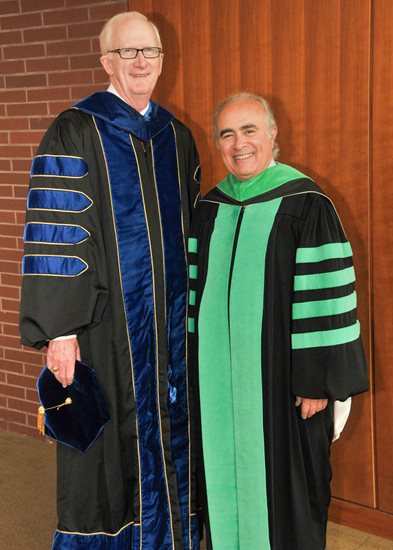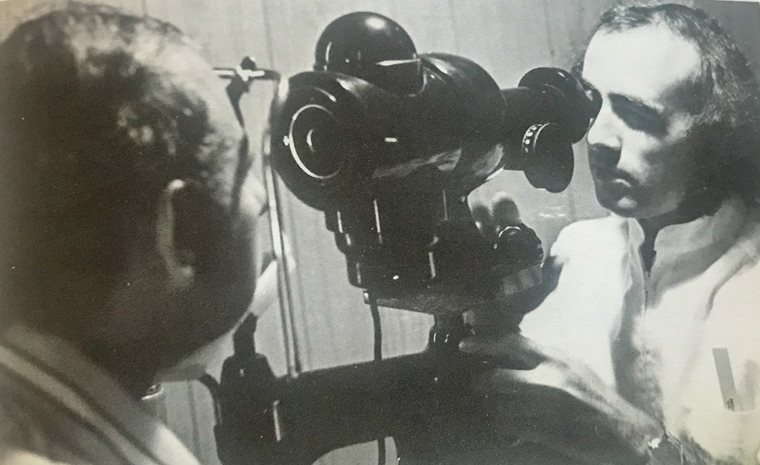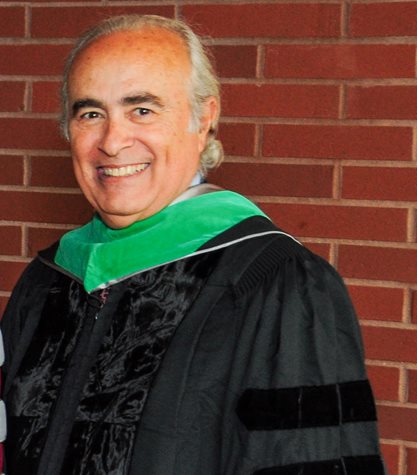
When Dr. Thomas Lewis first met Dr. Anthony Di Stefano, it didn’t take him long to determine the two were very different people.
“It took me about 30 seconds to figure that out,” said Lewis, OD ’70, PhD, FAAO, past president of Salus University and professor in the University’s Pennsylvania College of Optometry (PCO). “I’m conservative and he’s ultra-liberal. We come from different backgrounds and see the world very differently.”
But that didn’t prevent the two from becoming fast friends and working together for the greater good of the institution and become two of the driving forces at PCO and then Salus University.
Dr. Di Stefano, OD ’73 officially retired on July 1, 2019, after a long and successful career at Salus University. He’s known as the architect of the University’s Public Health programs, specifically designed to bridge the gap in public health training in professions such as optometry, audiology, blindness and visual impairment, physician assistant studies, occupational therapy and speech-language pathology. He has long believed these professions were are under-represented in the public health sector, thereby lacking sufficient public health trained individuals to effectively impact the population’s health challenges across the global healthcare system.
 When Dr. Lewis returned from teaching in St. Louis in 1972, Dr. Di Stefano was just graduating from PCO in 1973. By 1975, Dr. Di Stefano had returned to PCO and had become what Dr. Lewis called "the golden boy for president Dr. Norman Wallis.” According to Dr. Lewis, Wallis “saw in Tony his brilliance and talents and made him head of strategic planning for the University at a very young age and he was very successful at that.”
When Dr. Lewis returned from teaching in St. Louis in 1972, Dr. Di Stefano was just graduating from PCO in 1973. By 1975, Dr. Di Stefano had returned to PCO and had become what Dr. Lewis called "the golden boy for president Dr. Norman Wallis.” According to Dr. Lewis, Wallis “saw in Tony his brilliance and talents and made him head of strategic planning for the University at a very young age and he was very successful at that.”
Before Dr. Lewis became president of the University, he was dean and vice president of Academic Affairs for PCO. When Dr. Lewis assumed his new position in 1989, he appointed Dr. Di Stefano to replace him. And, for the entire 24 years that Dr. Lewis was president of the College and then University, Dr. Di Stefano served as dean and vice president of Academic Affairs.
“I can’t speak for him, but I had a tremendous respect for him and I believed in him. I think he’s brilliant,” said Dr. Lewis of Dr. Di Stefano. “What he thinks of me, I’m not exactly sure. But we worked well together. I would fight him on certain things that I didn’t think were practical. But I respected his right to have an opinion and I respected his expertise and knowledge.”
When not being at odds, the two were truly friends. They’d talk about baseball and their families, as well as politics. But when they talked business, it eventually always came back around to what was best for the University.
“He and I still disagree on everything,” said Dr. Lewis. “There are times when I was extremely frustrated with him and I’m sure there were times where he was extremely frustrated with me. But I think we always did things that we thought were for the better good of the institution. If you ultimately have that as your premise, and not your own ego or your own agenda, then things tend to work out.”
Dr. Jerald Strickland, PCO Dean from 1975 to 1979, first met Dr. Di Stefano when the former returned to PCO from Indiana University in 1974. But he had heard of him a few years earlier.
While a student at PCO, Dr. Di Stefano was a student advocate, and at that time, there were some issues then between the students and the PCO administration. According to Dr. Strickland, Dr. Di Stefano was one of only a few students standing up for students’ rights.

“When I first met him, I loved him. Whatever he was saying about the previous administration, I was willing to believe,” said Dr. Strickland.
Dr. Di Stefano and Dr. Strickland worked closely together helped forge their relationship. “I was a whole lot more like Tony. We talked the same language and we had the same kind of communication skills,” said Dr. Strickland.
“Dr. Norman Wallis was the president at the time and he had written, along with Tony and with some input from me, a grant to build The Eye Institute,” said Dr. Strickland. “There were a lot of programs and a lot of equipment we needed for that, so Tony and I wrote grants together, besides doing our regular administrative work.”
At that time, grant requests had to be taken to what was called the Health, Education and Welfare Department in Washington, D.C. (now the U.S. Department of Health and Human Services). The two would meet at the train station every other Thursday morning and head to the nation’s capital.
 “So, we were together a lot, we planned a lot, we negotiated a lot,” said Dr. Strickland. “And we were able – frankly through Tony’s influence in public health – to define what’s called primary care optometry in terms of public and community health. That was really significant, to place optometry within the healthcare system at that time, when it seemed to be standing alone outside the system.”
“So, we were together a lot, we planned a lot, we negotiated a lot,” said Dr. Strickland. “And we were able – frankly through Tony’s influence in public health – to define what’s called primary care optometry in terms of public and community health. That was really significant, to place optometry within the healthcare system at that time, when it seemed to be standing alone outside the system.”
According to Dr. Strickland, a good part of Dr. Di Stefano’s legacy at Salus and PCO was keeping public health in the limelight. “He placed the University in terms that the entire community of public health would understand,” said Dr. Strickland. “I think the model that they developed and the additional colleges that they have embraced have made for a well-rounded health science university.”
Dr. Lewis agreed.
“Tony is a very hard worker. His greatest talent was grant writing. His office looked like a bomb went off in it, but he had an innate ability to pull all of this stuff together. That’s why we got so many grants and were so well-funded in many different areas, because he is an excellent writer,” said Dr. Lewis.
“But I can say this without hesitation: This institution wouldn’t be anywhere near where it is now without Tony, said Dr. Lewis. He’s contributed so much to the growth and development and whatever success we’ve had, he’s been an integral element of it. He’s one of the five or six people in the history of this institution that have had the most influence.”